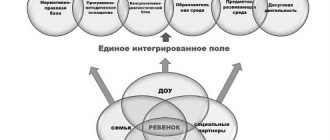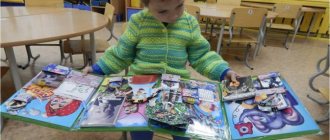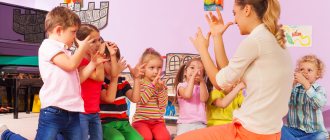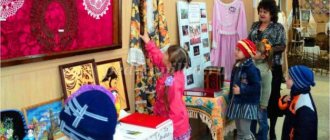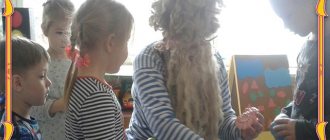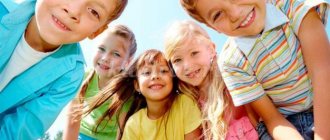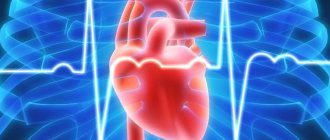Strengthening and protecting health from the first days of a child’s life is the task of every parent. And, as soon as the baby grows up and begins to attend kindergarten, teachers partially take on this task. The duty of any preschool institution is to take care of the physical and psychological well-being of pupils. Protecting children's health in preschool educational institutions
involves regular implementation of hardening, developmental and preventive measures. In addition, special attention is paid to building and maintaining a rational daily routine, quality nutrition and physical activity for each child.
Strengthening the health of children in preschool educational institutions
impossible without a range of physical exercises. Morning exercises, developmental activities, games and competitions, exercises for the prevention and correction of poor posture and flat feet, walks, exercises using sports equipment in the fresh air, etc. These activities strengthen the musculoskeletal system, improve blood circulation and breathing, help normalize digestion and metabolism, and strengthen the immune system, especially during periods of high risk of illness.
Methods for improving the health of children in preschool educational institutions also focus on the development of positive emotions in pupils. Physical education and sports activities do not aim to hone the technique of performing exercises. They are aimed at developing interest in sports and physical activity, promoting the emergence of positive emotions and strengthening children’s contact with teachers, teaching children to feel their body and move freely.
Finally, maintaining health in a preschool educational institution is impossible without hardening procedures. Hardening techniques change throughout the year, depending on weather conditions and the situation with the spread of seasonal diseases (flu, ARVI, etc.). Also, the type of hardening procedure and its intensity may vary from student to student. An individual approach is important here, taking into account the health status of each child, the characteristics of his character, physique and immunity. In order for hardening not to harm, but to bring benefit, all these parameters must be taken into account.
Next, we will consider the different types of health activities and their features.
Physical education classes
Health improvement of a child in a preschool educational institution
necessarily includes physical exercise. These or other types of exercises are selected by the physical work teacher, taking into account the age of the children.
Thus, in younger groups, the main goal of classes is to teach children to navigate in space and work with simple sports equipment and equipment. In middle groups, classes are more focused on the development of physical qualities - strength, endurance, agility. In older children, they instill the need for active movement, teach independence, organization and group work.
Any physical activity should, first of all, bring joy to the child. Therefore, the correct methods for improving the health of children in kindergarten are always varied. These are not only traditional gymnastic and sports exercises, but also outdoor games of varying intensity, rhythmic exercises, competitions and relay races, story-based exercises and much more.
Health improvement for children in winter in preschool settings
Sheina Tamara Yuryevna Skrynnik Yulia Igorevna teachers MBDOU Kindergarten No. 3 village. Bekhteevka, Korochansky district, Belgorod region.
The material was sent for publication in the All-Russian printed collection of practice-oriented materials “Preschool and primary education - modern methods and technologies of teaching and upbringing” - OCTOBER 2022.
HEALTH HEALTH OF CHILDREN IN THE WINTER PERIOD IN PRESENTER CONDITIONS
Currently, one of the most important and global problems is the health of children. Raising a healthy child is the most important thing that needs to be done not only by parents, but also by kindergarten employees. Full physical development and health of a child is the basis for personality formation.
Advertising message
Protecting and strengthening the health of children, comprehensive physical development, hardening the body - this is the main goal of the staff of our kindergarten. Prevention of colds - in our preschool institution in the winter and not only, largely depends on the interaction of us, the teachers, with the physical education instructor and with the nurse. It is known that absolutely any disease is much easier and better to prevent than to treat it later. The best protection against a cold is its comprehensive prevention.
The basic preventive principles are simple, which we use in our kindergarten and are well known to everyone:
- Hardening procedures;
- morning exercises;
- carry out physical education activities in the fresh air;
- walking along a ribbed path barefoot;
- wash your hands up to the elbows with slightly warm water;
- rinsing your mouth after eating; etc.
- implementation of sanitary and hygienic regime;
- Constantly monitoring the child’s posture during games and activities
The system for preventing colds and improving the health of children in our kindergarten includes breathing exercises, health-improving exercises after sleep with elements of self-massage, and oxygen cocktails.
- – optimal motor activity, physical education;
- – regular ventilation, quartz treatment and wet cleaning of premises;
- – sufficient lighting and properly selected furniture;
- - exclude the possibility of personnel, as well as children with signs of influenza or ARVI, going to work;
- – vaccination against FLU, which is given immediately before the winter respiratory viral season.
Only with regular and systematic use will this complex help overcome frequent illnesses in kindergarten.
During winter, air and water hardening should be widely used.
A necessary condition is sufficient ventilation of playrooms and bedrooms, sports and music rooms. Proper quartzization and ionization of premises prevent the impact of some unfavorable factors of the winter season on the child’s body.
I, a middle school teacher, together with a physical education instructor, select exercises and classes for various types of physical improvement for children. The main ones are:
- – organization of independent motor activity of children in a group and on a walk;
- – preparation of recommendations for parents on organizing physical activity in the family.
One of the important conditions for hardening is also the full use of walking time to stay in the fresh air while gradually accustoming children to low temperatures, subject to the recommendations of SanPiN of August 2013, paragraph 11.5.
Clean air is the key to health. One of the elements of hardening is a walk in the fresh air. A walk in winter brings joy to children no less than in summer. In winter, my children and I enjoy playing with the snow: we sculpt snow figures, ride on ice slides.
Maximum use of the winter season for the health of children, their physical development, hardening, and emotional charging contributes to the protection of the health of the younger generation in our kindergarten.
In winter, favorable conditions are created to enhance metabolic processes and adapt the body to low temperatures.
When organizing the daily routine in winter in our kindergarten and directly in my group, the features of this season and the recommendations of parents are taken into account. In winter, there is a great opportunity for further development of basic movements - walking, running, throwing, etc., which are carried out in changed, more difficult conditions (slippery surfaces, weighted clothing, etc.).
To improve the child’s physiological functions and develop a variety of motor skills, I use outdoor games, winter sports exercises and outdoor entertainment. They develop strength, endurance, agility in children, make them bolder, more decisive, and foster a sense of teamwork.
Skiing, ice skating, sledding - these types of physical activity are acceptable only in winter and are needed by a person in all periods of his life.
We must not forget that when selecting winter clothing, it is necessary to strive for optimal thermal comfort, remembering the dangers of overheating in children.
Protecting and strengthening the health of children, comprehensive physical development, hardening the body - this is my main goal and the goal of all employees of our preschool.
Bibliography:
- Dybina O.V. Classes on familiarization with the outside world in the middle group of kindergarten. M.: Mosaic-Sintez, 2007.
- Korotkova T.A. Cognitive and research activities of an older preschool child in kindergarten – Preschool education – 2003.
- Prokhorova L.N. Organization of experimental activities for preschool children. –M.: ARKTI, 2005.
- Savenkov A.I. Educational research in kindergarten - Preschool education - 2000.
You can see the table of authors and learn more about the collections HERE
Hardening
Health improvement for children in kindergarten
impossible without hardening procedures. When working with children, it is important to follow the key principles of hardening:
- carry out hardening procedures only with healthy children;
- refuse hardening if the child reacts negatively to it - cries, worries, is afraid;
- start with gentle procedures, gradually moving to more intense ones;
- carry out hardening regularly and systematically.
In a kindergarten, a medical worker must keep a hardening notebook, where the procedures performed, the children’s reaction, the results achieved and available medical outlets will be noted.
Basic hardening techniques, which include health improvement work in a preschool educational institution
:
- extensive washing with cool water. The child alternately runs wet palms over both arms from the hand to the elbow, then over the neck, upper chest and face, after which he wipes himself dry;
- daytime sleep without T-shirts - this procedure can be carried out in the warm season;
- rinsing the mouth with an iodine-salt solution (3-5 drops of iodine and a tablespoon of salt per 1 liter of water at room temperature), recommended after exercise or napping;
- walking barefoot;
- the so-called “Riga technique” - walking on a mat with rubber spikes soaked in saline solution.
“Organization of recreational work during the day with preschool children”
Organization of recreational work during the day
with preschool children
The goal of health work in preschool educational institutions is to preserve and strengthen the physical and mental health of children, improve their physical development, and introduce them to a healthy lifestyle.
Health activities in kindergarten allow the child to cope with the difficulties of getting used to a new environment, allow them to organize the child’s life in a preschool institution in such a way that leads to the most adequate, almost painless adaptation to new conditions, and the formation of a positive attitude towards all types of everyday life.
Wellness activities take an integrated approach and are built on three main areas:
- Creation of a healthy environment for the prevention of various deviations in psychophysical development in children (vision, flat feet, poor posture, articulation apparatus, breathing).
- Formation of a healthy lifestyle for children in kindergarten and at home.
- Development of physical qualities of preschool children.
The deterioration of children's health dictates the need to develop and implement health-improving measures aimed at improving children's health and reducing their morbidity.
Mode
– this is the correct distribution in time and the correct sequence in satisfying the basic physiological needs of the child’s body: sleep, eating, wakefulness. The correct regime ensures a balanced, cheerful state of the child, protects the nervous system from overwork, and creates favorable conditions for the physical and mental development of the child. If this most important condition is not met, deviations in the child’s behavior, whims, increased and decreased excitability, poor sleep, lack of appetite, etc. can be observed.
The daily routine of preschool children is based on the fact that children sleep only once during the day for 2-2.5 hours, the time of active wakefulness is extended to 6-7 hours, and their night sleep is 10 hours.
In a preschool institution, the daily routine is structured in accordance with the age of the children. It is necessary that parents understand the importance of this particular condition for the child’s health. Unfortunately, in many families, especially young ones, the regime is neglected, and this inevitably harms the child.
According to many observations, children attending preschool institutions most often get sick after weekends and holidays. And this happens because the child is not provided with the routine to which he is accustomed, to which he was tuned in in kindergarten: they go to bed later in the evening, daytime naps are canceled, walks are replaced with games at home, and they are allowed to watch TV shows as much as they want.
All this affects the fragile child’s body, the functions of all its organs and systems deteriorate, thereby inevitably weakening the protective mechanisms. The child's preschool regime at home should be a continuation of the kindergarten regime; without this, it is difficult to expect success from hardening.
The system of health-improving measures is reflected in the content of health-improving work with preschool children:
I. Motor activity
- Morning exercises for the overall development of the child are carried out every morning.
- Physical education and health classes – 3 times a week (2 times indoors and 1 time for a walk).
- Active and dynamic games - every day during the day.
- Physical exercises.
- Gymnastics after a nap - every day.
- Preventive gymnastics (prevention of scoliosis and poor posture, prevention of flat feet, eye gymnastics) - daily.
- Breathing exercises - daily.
- Walks - daily.
II. Hygiene and water procedures:
- Washing and washing hands daily.
- Games with water – once a week.
- Compliance with the drinking regime - daily.
- Air recirculation and disinfection – daily.
III. Using the natural environment for hardening activities:
- Ventilation of premises - daily.
- Sleeping with the transom open - every day in the summer.
- Walks in the fresh air - daily.
- Providing light conditions.
IV. Hardening:
- Walking barefoot. The main point of walking barefoot is to harden the skin of the feet to the effects of low temperatures, mainly the floor and earth.
- Rinse your mouth with cool water daily.
- Air baths.
- Reasonable clothing.
V. Balanced meals 5 times a day.
VI. Fortification, including vitamin “C” in the third dish.
VII. Working with parents on children's health issues:
- Individual conversations.
- Consultations.
- Parent meetings.
- Health corners.
- Mobile folders.
Thus, the main thing is to teach children from a very early age to value, protect and strengthen their health. This is a cheerful, active, friendly, inquisitive child. The development of the child’s physical qualities proceeds harmoniously. He is durable, fast enough, agile and strong. The mode of his life activity is carried out in accordance with the individual biorhythmological portrait with an optimal ratio of periods of ups and downs of activity, wakefulness and sleep. He is not afraid of unfavorable weather factors or sudden changes in them, since he is hardened, his thermoregulation system is well trained to multidirectional temperature influences, so he does not know what a cold is. Thanks to a balanced diet, this child does not have excess body weight, he has every opportunity for normal harmonious growth and development. Favorable psychological conditions in the family and in the preschool institution contribute to the strengthening of his mental health. The task of all of us, adults, is to create conditions for raising such children.
Preventive actions
Health of preschool children
is also supported by a set of preventive measures aimed at preventing colds and other diseases. Such measures include sets of visual exercises to prevent myopia, gymnastics with the simplest elements of yoga, breathing exercises, sleeping without pillows, self-massage of the earlobes and auricles.
During training sessions, pauses are required for relaxation, breathing and vision training. Particular attention is paid to the optimal motor mode, which is the best prevention of flat feet and postural disorders.
Finally, the preservation of the health of children in preschool educational institutions is ensured through the organization of a high-quality and safe environment. This, first of all, includes regular wet cleaning of kindergarten premises, ventilation, and maintaining optimal temperature conditions. Rooms where children play and sleep should receive sufficient natural light. In the autumn-winter period, as well as in the northern regions, the lack of natural light can be compensated by installing fluorescent lamps.
Physical education classes may be accompanied by music. A musical background promotes better coordination of movements, improves mood and stimulates children's activity.
How to monitor the health and morbidity of children?
It is convenient to use special software to analyze morbidity and maintain medical journals in kindergarten. For example, the “Medical Cabinet” software module of the System for Monitoring the Activities of an Educational Institution (SKDOU). It contains more than 30 medical journals that help monitor the health and morbidity of children, monitor dietary nutrition and the quality of food preparation, comply with food standards and the sanitary condition of premises, etc.
This is how, for example, the system looks like the formation of a vaccination plan and a schedule based on one of the morbidity reports:
You can download a free demo version of this program here.
Author of the article: Lidiya Sitnikova
